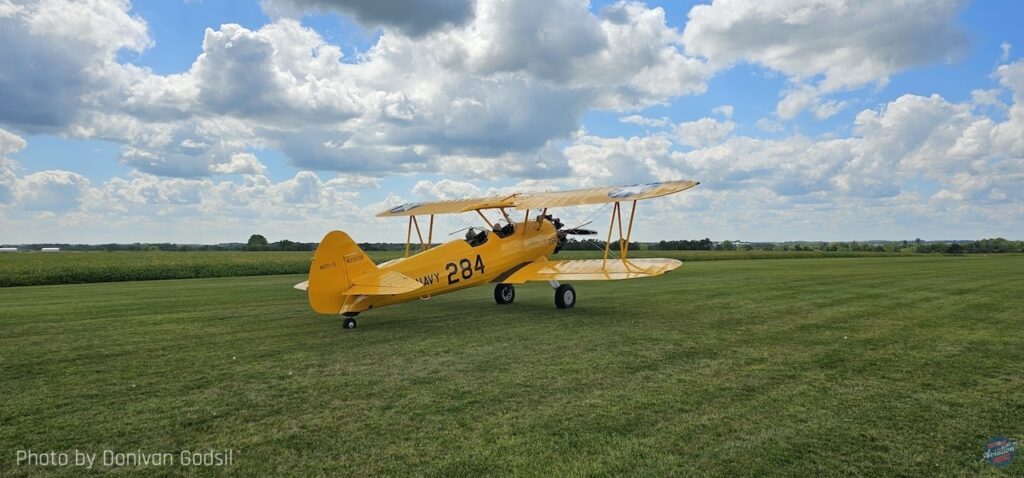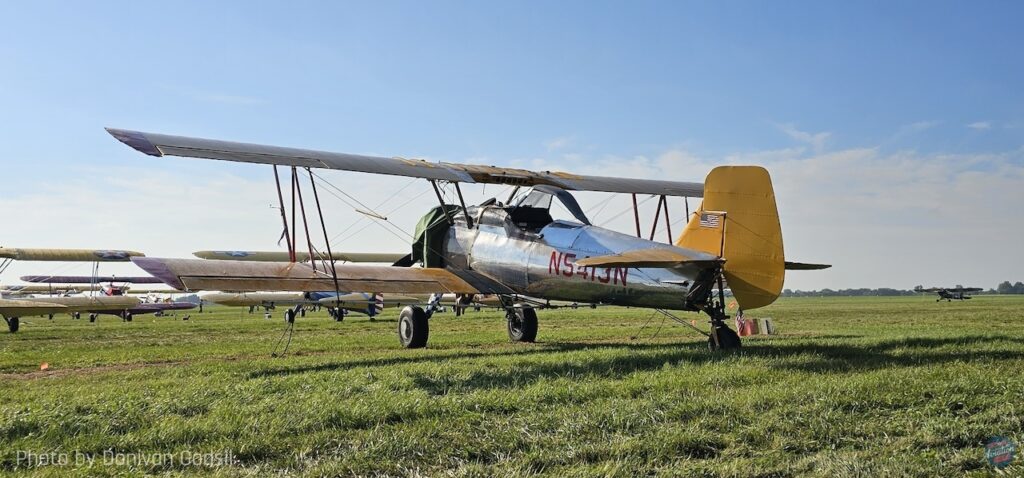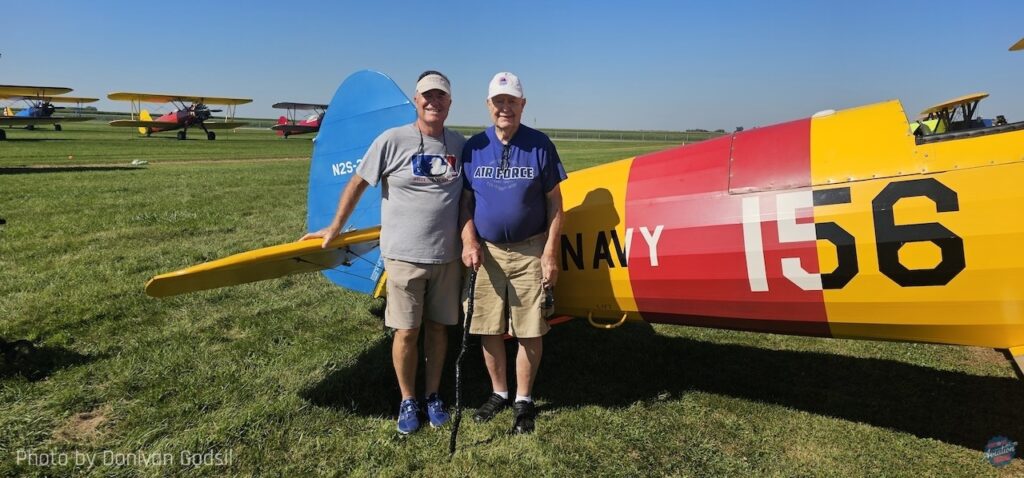The National Stearman Fly-In started back in 1971 when Tom Lowe of Crystal Lake, Illinois, and the late Jim Leahy, of Galesburg decided to get a few folks together who loved and flew these iconic biplanes of the 30s and 40s. The first annual fly-in held in 1972 had around 30 stearmans from all over the country, and they encouraged the working girls (also known as crop dusters), military stock, civilian, and 450-hp airshow performers to come! In these early years, we did not have social media like there is today. Between word-of-mouth and the post office, this event began to take shape as one of the longest type-fly-ins of its kind.
What can you possibly do for a whole week in Galesburg, you might ask. Easy! Some pilots come to Galesburg, park their airplane and just enjoy the fellowship for the week. There are seminars, lunches, a poker run, and different fly-outs and contests all week to participate in if you’d like. The event begins officially on Labor Day, starting with a fly out breakfast to Kewanee (The Hog Capital of the world), followed by a parade fly-over in Galesburg which holds the title of America’s longest running Labor Day Parade. Monday night, a fine picnic is sponsored by a vendor. On Tuesday, for the last several years, Dave and Kathy Shipley host a fly-out lunch at the Tri-County Airport (2C6) in Yates City, IL. It’s one of the smoothest pieces of grass you could land on. This year, they had an impressive 46 Stearmans on their airfield, an Elvis impersonator performing, and provided a wonderful lunch. The Shipleys are very welcoming and always have an open door for pilots who need a spot to rest, and are some of the friendliest people in aviation. Wednesday is another fly out to Kewanee for lunch, and a flyover of the Prime Beef Festival parade in Monmouth, IL.
Thursday is another favorite fly out to Gen-Air Park (3G8) in Geneseo, IL for lunch and an aerobatics contest. This contest is one of the most historical events of the fly in. In years past, we have had airshow icons such as Walt Pierce and John Mohr be judges, and even hosted a Master’s contest for prior 1st place winners of stock and modified categories. Friday’s events are the Wolford Picnic in Abingdon, IL (IL01) and the short field takeoff, flour bomb drop, and spot landing contest. The Stearmans are classed by horsepower and is probably one of the tightest competitions of the week. There is a catered meal, followed by a guest speaker in the evening. Saturday was full of emotions and was one of the busiest days of the event. Emotional because it’s the last day of the fly-in, and our friends were starting to pack up for their trip home. The big event on that day was another held in the utmost regard; Formation Contest. In years past, there would be several four-ship teams and it seemed like hours of formation flights overhead the airport would be taking place. In recent years, there are two or three teams who participate. This gives you the sights and sounds of our Greatest Generation flying in formation in their training to go on to bigger and more advanced aircraft. At the end of the contest, the last team performs a missing man formation in honor of those beloved friends who’ve gone west. It’s somber, but one of the most beautiful gestures you can experience.
Seminars are quite popular during the week, discussing everything from aeromedical information, restoration work, formation flying, and other related topics. All week, there are narrated tram rides available for the public to get up-close on a guided ride through the flight line. Vendors set up to sell souvenirs and parts, and the new International Stearman Community Hangar hosts its own gift shop, historical library, and museum inside. During the fly-in, we have seen an average of 70, and our record is 156 Stearmans (at the 50th National Stearman Fly-In). This year, the total was 78. There are usually two from Canada that come down, a few from the West Coast, and several from the southern states. Recently a gentleman from Alaska flew 34 hours from Anchorage, and told me if a hangar would have been available, he would consider leaving his Stearman here and just restoring another one back home! According to the FAA Registry, there are over 50 Stearmans within 200 nm of KGBG. These are incredible aircraft, but there aren’t too many pilots today that will fly in our climate year round. However, another Illinois native told me that he enjoys picking Santa up at one airport and flying him into another town in mid-December to kick off a Christmas event.
Of the Stearmans you will see here, many are your typical all-yellow “Navy” planes and yellow and blue “Army” airplanes. Awards are given out to historical accuracy, such as the Yellow Peril (Navy) and Kaydet (Army), Best Civilian, et cetera. It is hard for me to ever say what my favorite Stearman is, because every single one of them, no matter how old the restoration is or how fresh, are my favorite as long as I’m looking at it. Many of these caretakers spend countless hours researching historical data down to the delivery dates and have their aircraft looking exactly as it would have in WWII. They go through great lengths to preserve history, yet allow modern items of safety and convenience, such as LED lighting, radios, transponders and ADS-B equipment. It is a treat to arrive at the airport and hear the Lycomings, Continentals, Pratts, and the unique Vedenyev M-14 on one particular Canadian stearman come to life on the flightline and watch them taxi out. Based in Galesburg is a 600-hp Stearman, affectionately known as “The Beast.” It’s still configured as a cropduster, with gauges in the center section, a hopper, pump, and booms, with flat-bottom high lift wings, a metal covered fuselage and the most distinct looking “stearman” tail you’d ever find.
This year, there were two very eye-catching stearmans on the line that brought a lot of attention. One, owned by Tom Torchia of Arizona. The Recall Stearman. It’s white and blue stripes along the wings, tail and fuselage stand out as unusual because it’s not the typical stearman scheme we are used to. The aircraft in recall colors were used in the days before ATIS and reliable communications, where they would launch and fly to the practice areas. The cadets in training would see the recall plane and know this was the signal to get back to base and on the ground, either for weather or other unknown reasons. Tom finished his airplane this spring and flew it to Oshkosh before making his way to Galesburg.
Another Stearman had a 600 horsepower Pratt on the nose. It also had 50 caliber machine guns below each wing, and a “bomb” between the mains. “The Ghost Ship,” also from the greater Phoenix area, is unlike any other PT or N2 series Stearman out there. Clipped wings, four ailerons, big engine, skinny wheels and wheel pants, with similar markings to the Boeing P12, this example is more fantasy than war-time accuracy. Nonetheless, it’s grabs the attention of the viewer and creates quite the conversation. Of note, some export Stearmans did in-fact carry armament, but we haven’t seen the real ones at Galesburg…but there is still hope. There’s one row dedicated to Pratt & Whitney powered Stearmans. Two of them this year are still wearing the Red Baron Squadron scheme, and a few others were cowled up like most imagine Super Stearmans ought to look. One was different though, it was the Model 4E Speedmail. With its wide stance, long wing and nose, and square tail it takes you back to the 1930’s in art deco style. This particular one lives in middle Iowa, and is easily one of the most luxurious Stearmans flying. You don’t need to own a Stearman to attend or participate in any of the fly-outs. There are plenty of Stearmans to “try on” and two usually sell scenic and aerobatic rides all week, some are even for sale! The 54th National Stearman Fly-In starts September 1, 2025, so mark your calendars! Visit the website HERE for more info.






































![Planes of Fame Air Museum Receives a New Stearman 11 PT-17 Stearman 41-8746/N555BF arrives at Chino. [Photo via Planes of Fame]](https://vintageaviationnews.com/wp-content/uploads/Planes-of-Fame-Air-Museum-accepted-the-donation-of-a-Stearman-PT-17-150x150.jpg)


















